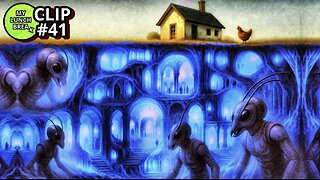Premium Only Content

Notes on the Ricercari
Ricercari in the 16th century: M.A. & G. Cavazzoni, de Paiva, Valente, de Cabezón &
Frescobaldi, Froberger, Storace, Krieger - Ricercari in the 17th century
Ricercari are contrapuntal instrumental pieces, mainly in the 16th and 17th centuries. Mostly they were composed for keyboard instruments or lute. Their structure sometimes corresponds to the motet, chanson and madrigal - they consist of several parts / sections that perform a soggetto, a small melodic theme.
The imitation ricercare leads to the fugue.
The term ricercare, associated with Italy and Germany, means to search; when improvising or composing, one searches for possibilities of thematic imitations.
Iberian composers do not use this term. De Paiva's Ricercare is an untitled piece of music without text that is easy to finger on keyboard instruments. De Cabezón's Tiento corresponds to a ricercar. In Italy, too, the terminology is not clear. Ricercare, fantasia, and sometimes also canzona and capriccio cannot be exactly separated.
Our examples come from different regions and sometimes have different titles. Also the notations in the sources are different.
Frescobaldi's Ricercari are printed as a four-part score.
Krieger's, Storace's, and M.A. Cavazzoni's ricercari are notated in modern-style piano systems.
Cabezón's music is notated in Spanish numeral tablature, and Valente's ricercare is notated in a modified form of numeral tablature.
Sources: Relevant articles from The New Grove, MGG, and Oesterreichisches Musiklexikon online.
---
Los ricercari son piezas instrumentales contrapuntísticas, principalmente de los siglos XVI y XVII. En su mayoría fueron compuestas para instrumentos de teclado o laúd. Su estructura corresponde a veces al motete, la chanson y el madrigal: constan de varias partes/secciones que interpretan un soggetto, un pequeño tema melódico.
La imitación del ricercare conduce a la fuga.
El término ricercare, asociado a Italia y Alemania, significa buscar; al improvisar o componer, se buscan posibilidades de imitaciones temáticas.
Los compositores ibéricos no utilizan este término. Ricercare, de De Paiva, es una pieza musical sin título y sin texto que resulta fácil de digitar con instrumentos de teclado. El Tiento de Cabezón corresponde a un ricercar. También en Italia la terminología no está clara. Ricercare, fantasía, a veces también canzona y capriccio no se pueden separar exactamente.
Nuestros ejemplos proceden de distintas regiones y a veces tienen títulos diferentes. Las anotaciones en las fuentes también difieren.
Los Ricercari de Frescobaldi se imprimen como una partitura a cuatro voces.
Los ricercari de Krieger, Storace y M.A. Cavazzoni están anotados en sistemas pianísticos de aspecto moderno.
La música de Cabezón está anotada en tablatura numérica española y la de Valente en una forma modificada de tablatura numérica.
Fuentes: Artículos relevantes de The New Grove, MGG y Oesterreichisches Musiklexikon online.
https://youtu.be/DTkvWxLDAk4
https://youtu.be/qvMY5SsHNvE
https://rumble.com/vkqm7v-ricercari-in-the-16th-century-m.a.-and-g.-cavazzoni-de-paiva-valente-de-cab.html
https://rumble.com/vlbr5u-frescobaldi-froberger-storace-krieger-ricercari-in-the-17th-century.html
-
 LIVE
LIVE
The Rubin Report
1 hour agoJordan Peterson Makes Joe Rogan Go Quiet with This Chilling Warning for the ‘Right’
3,418 watching -
 LIVE
LIVE
Benny Johnson
1 hour ago🚨 Elon Musk Makes SHOCK Announcement About Future in Trump Admin | Klaus Schwab Under INVESTIGATION
7,290 watching -
 UPCOMING
UPCOMING
The Shannon Joy Show
2 hours ago🔥🔥Corruption At HHS Under RFK Jr? Explosive New Substack From Dr. Mary Talley Bowden Exposing How #MAHA Frontman Calley Means Plans To CASH IN On Leverage At HHS. With Special Guest - Major Tom Haviland!🔥🔥
211 -
 22:01
22:01
Stephen Gardner
1 day ago🔥Trump CRUSHES ABC lie, Johnson DEMANDS new 9/11 PROBE!
13.4K117 -
 UPCOMING
UPCOMING
Grant Stinchfield
18 minutes agoWhat is the "Woke Right?" - Is there a Push to Make the Hatred of Jews Cool?
-
 24:20
24:20
Rethinking the Dollar
1 hour agoTrump Backs Down on China Tariffs—Markets Explode Upward | Morning Check-In
53 -
 LIVE
LIVE
BitLab Academy
2 hours agoBitcoin Trade War Pump: ATH Over Stock Market | Bit Bonds & Key BTC Signals
133 watching -
 1:01:18
1:01:18
VINCE
3 hours agoKristi Noem On The Border, Deportations, The Secret Service and More | Episode 28 - 04/23/25
153K85 -

MYLUNCHBREAK CHANNEL PAGE
22 hours ago18 Levels Under Ground?
17.9K6 -
 LIVE
LIVE
Caleb Hammer
2 hours agoI Had To Kick This Dipsh*t Off Financial Audit
119 watching